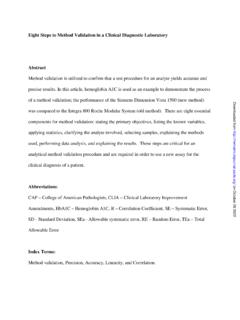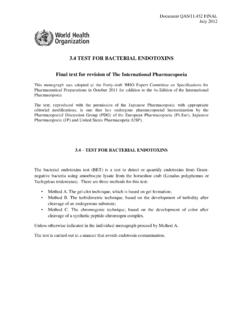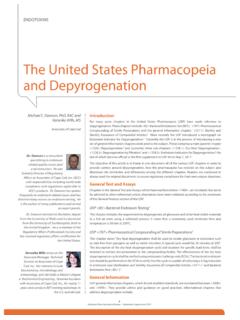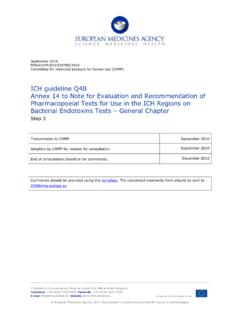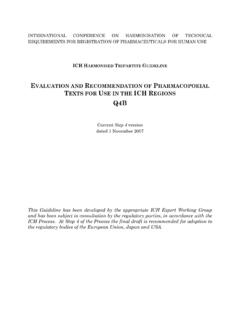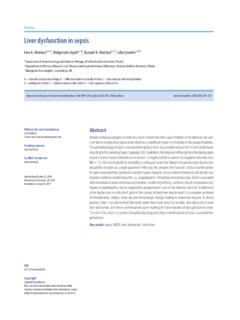Transcription of Biomarkers of Infection and Inflammation
1 Downloaded from on January 12 2022. 1. Copyright 2020 by . Biomarkers of Infection and Inflammation Abstract Biomarkers , or biological markers, have been tested in the clinical laboratory for decades. More recently, there has been a surge in research studies aimed at identifying Biomarkers of Infection and Inflammation . One of the foremost motivators in this expansion of research is the quest to find ideal Biomarkers for sepsis. Traditional, yet still relevant, laboratory markers of Infection and Inflammation consist of the white blood cell count, erythrocyte sedimentation rate, and C- reactive protein.
2 Newer Biomarkers that are currently available in the clinical laboratory and used Downloaded from on January 12 2022. for the evaluation of sepsis include lactate and procalcitonin, while two promising emergent Biomarkers for the evaluation of sepsis, pentraxin 3 and presepsin, are presented. Beyond sepsis, promising emergent Biomarkers for chronic wound infections , pneumonia, and invasive fungal infections are also discussed. 2. LEARNING OBJECTIVES: 1. Define the term biomarker . 2. Describe the traditional, newer, and future Biomarkers of sepsis discussed in this article.
3 3. Identify the emergent Biomarkers of chronic wound infections , pneumonia, and invasive fungal infections discussed in this article. Downloaded from on January 12 2022. 3. ABBREVIATIONS: BDG - 1,3- -D-glucan, CD - cluster of differentiation, CRP - C-reactive protein, ESR - erythrocyte sedimentation rate, FDA - Food and Drug Administration, GM - galactomannan, HNE - human neutrophil elastase, IL - interleukin, MALDI-TOF - matrix-assisted laser desorption ionization time of flight, PCT - procalcitonin, PTX3 - pentaxin 3, WBC - white blood cell Downloaded from on January 12 2022.
4 4. Downloaded from on January 12 2022. 5. Biomarker, Infection , Inflammation , sepsis INDEX TERMS: INTRODUCTION TO Biomarkers . Identification of microorganisms and their antimicrobial susceptibility patterns are the primary objectives of a microbiology department. Other laboratory departments (in particular clinical chemistry and hematology) have played a supportive role in the diagnosis of Infection with the detection and quantification of circulating markers, known as Biomarkers . As the microbiology department has evolved due to technological advances, we have also seen a boom Downloaded from on January 12 2022.
5 In research to discover superior Biomarkers of Infection and Inflammation . The term biomarker can have different meanings depending upon the context, thus in 2001 it was standardized as a characteristic that is objectively measured and evaluated as an indicator of normal biological processes, pathogenic processes, or pharmacologic responses to a therapeutic intervention .1 With this definition, Biomarkers encompass results of laboratory testing, imaging techniques ( , magnetic resonance imaging), and recordings of physiological tests ( , blood pressure, electrocardiogram).
6 2-6 Biomarkers are often classified by their application for diagnostic, predictive, and prognostic purposes, monitoring of treatment, pharmacodynamic response, and Diagnostic Biomarkers detect the presence of disease while prognostic Biomarkers are used in identifying the probability of disease recurrence or progression. Predictive Biomarkers aid in identifying those who will respond to ,7. Monitoring of treatment Biomarkers are used to assess the status of a disease. Biomarkers that change in concentration upon exposure to a medical product are known as pharmacodynamic response ,7,8 Lastly, safety Biomarkers indicate the presence or risk of an adverse event due to medical ,4.
7 Biomarkers IN THE CLINICAL LABORATORY. 6. For this review, the definition of a biomarker provided by the National Cancer Institute (part of the National Institutes of Health), a biological molecule found in blood, other bodily fluids, or tissues that is a sign of a normal or abnormal process, or of a condition or disease will be used as it is more specific to laboratory Biomarkers have been detected since the beginning of the twentieth century, yet the term is relatively ,10 Examples of established Biomarkers include pancreatic enzymes (amylase and lipase), acute myocardial infarction markers (creatine kinase-MB and cardiac troponin), kidney metabolites (creatinine and urea), Downloaded from on January 12 2022.
8 Liver enzymes (alanine aminotransferase and aspartate aminotransferase), and tumor markers (prostate-specific antigen and cancer antigen 125).6,10 Biomarker research has expanded over the past few decades due to their potential to improve success rates in drug development and advances in omic (genomics, transcriptomics, proteomics, peptidomics, and metabolomics). Nevertheless, the number of Biomarkers cleared by the United States Food and Drug Administration (FDA) has not increased. According to Pavlov (2013), this is due to the lengthy and challenging process of going from biomarker discovery to FDA clearance for clinical The FDA has a pathway for developing disease-related Biomarkers that consists of a multistep A simplistic description would be to describe the pathway occurring in four main phases.
9 The first phase is discovery and consists of exploratory studies that are performed to identify promising ,11 The second phase is analytical validation that includes analysis of performance metrics ensuring the test is reliable, reproducible, and of adequate sensitivity and specificity. The next phase is clinical validation that focuses on how well the test measures a clinical feature of the disease, disease outcome, or outcome of treatment. The final phase is clinical utility and is established by how well the test either confirms a diagnosis, 7. improves patient outcomes, determines appropriate treatment, or monitors Assay development is interwoven within the phases as it is a continuous process that begins after discovery but can be modified throughout any phase of the The multi-phase process described above is a long and arduous journey that can take up to 10 years from discovery phase to clearance by the Researchers encounter many challenges throughout this lengthy process.
10 Major challenges include relatively high false- positive rates, lack of rigorous validation studies, or scarcity of data showing significant Downloaded from on January 12 2022. contribution to clinical With each phase, the financial burden increases and often industry enters after the second phase to provide financial support. Industry involvement presents new challenges, such as ownership of intellectual This article focuses on Biomarkers of Infection (primarily bacterial infections ) and Inflammation . Biomarkers of Inflammation are included as they typically rise in response to an Infection .
